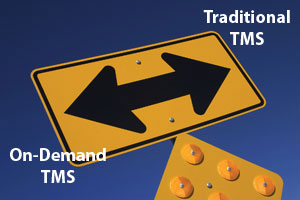Adrian Gonzalez, a transportation analyst at ARC Advisory Group, notes that there are some real cost benefits from the on-demand model, such as being able to re-use integration with carriers.
“Carrier connectivity, which is a time- and labor-intensive process with in-house implementations, is greatly simplified with on-demand,” Gonzalez told SDigest. That’s because the TMS vendor can just leverage existing carrier connections, rather than rebuilding them each time, as often happens in traditional TMS implementations, he said.
Gonzalez adds that in general, on-demand TMS implementations do tend to be simpler projects.
“Most on-demand TMS implementations are North American-trucking centric, so the scope is often fairly limited and standard,” he said. He also said that many on-demand TMS solutions are implemented in a piece-meal fashion, which lowers initial implementation costs.
“A customer might start with basic execution, then add optimization, then add freight audit and settlement, etc., over time,” Gonzalez added.
 Core Effort Should Still Largely be the Same
Core Effort Should Still Largely be the Same
Still, others are also confused at why on-demand TMS implementations seem to involve less total effort.
“The idea that an on-demand TMS application does not require significant up-front implementation effort or cost is a fool’s errand,” says David Schneider, president of David K. Schneider & Company, LLC, and former logistics executive at auto parts retailer Pep Boys.
Speaking from his own experience implementing an on-demand TMS at Pep Boys, Schneider says that even with a fairly straightforward, execution-oriented system, “There are integration efforts needed on both sides of the relationship. On the shipper side, there is interface files needed to transfer order or shipment information into the TMS. There are the origin and destination points that have to be built in the system, listing the physical address info and contact info. Carriers have to be created, again with contact info. Rate files have to be created, which requires a fair amount of work,” Schneider says.
He adds: “A user file (both internal, and external) that listed the users also must be built, including what processes they have access to (view, change, create, delete) and security group schemes. There is often additional EDI integration between the carriers and the TMS vendor that still has to be done. Every new carrier had to be integrated, and even existing carriers have to be tested for the data sets required by the customer.”
Schneider says that, in total, for his project, the TMS implementation costs were more than $400,000 – though he is quick to add the project still offered a substantial payback.
He also agrees that the process and change management issues and effort are the same regardless of whether the TMS is on-demand or traditional – effort which can involve a lot of cost.
“When you start one of these systems up, there is a huge business process change. You are changing the way that a broad population of loosely interrelated people conducts millions of dollars of business,” he told us. “You are replacing phone, fax and email with web pages and EDI processes. You are moving the management of a transportation enterprise from a flexible, human-enabled “system” to an electronic system that still requires the discipline and support of a broad population of loosely interrelated people.”
Do on-demand TMS implementations tend to be easier and cost less because they really are – or because the scope has been “dumbed down?” What’s your experience – or perception? Let us know your thoughts at the Feedback button below.